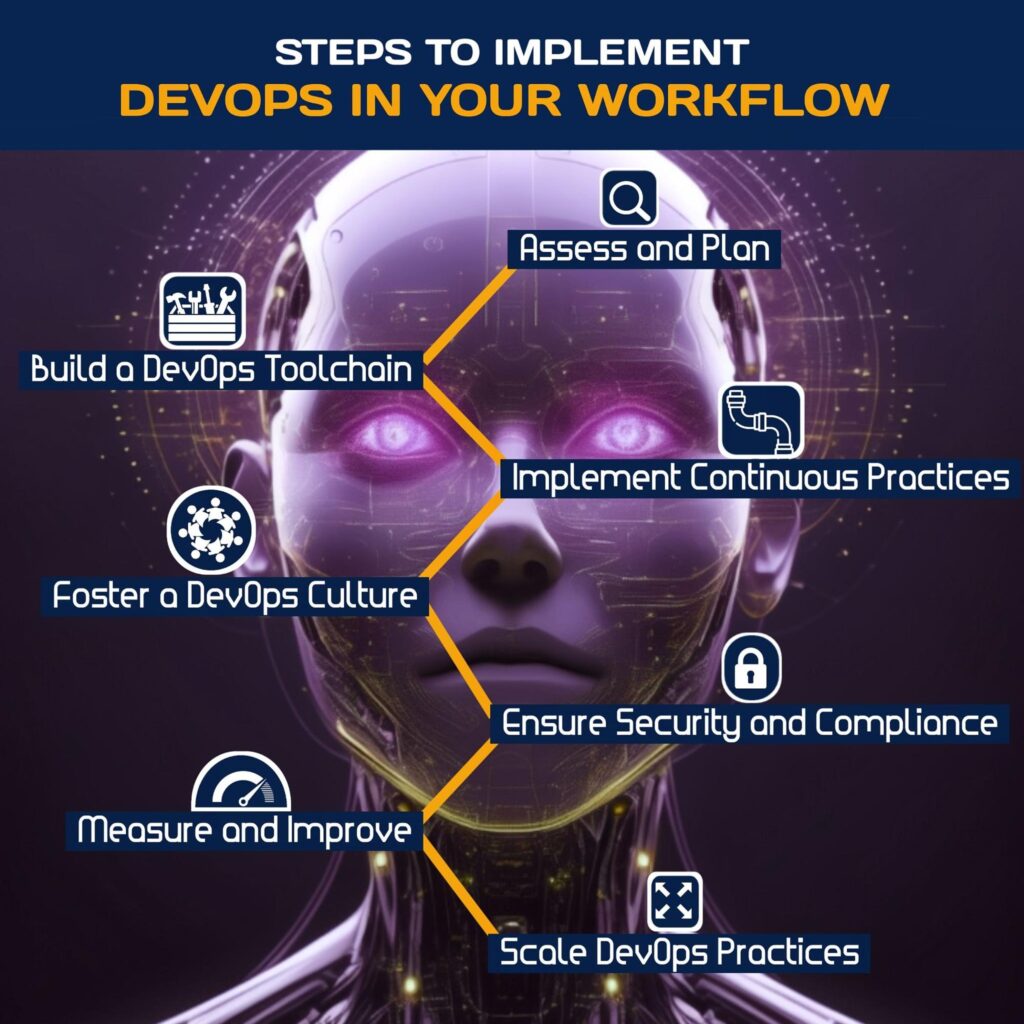Essential DevOps Best Practices Everybody Should Know
 29 March 2024
29 March 2024? Listen to the Summary of this article in Audio
DevOps best practices have revolutionized the landscape of software development, merging the once-segregated roles of development (Dev) and operations (Ops) into a cohesive, agile unit. This integration not only streamlines the development process but also significantly enhances the speed, quality, and efficiency of software delivery. By adopting DevOps practices, teams can automate workflows, improve collaboration between developers and operations teams, and implement continuous integration and delivery pipelines. As the digital world continues to evolve, understanding and implementing these practices is crucial for any organization aiming to stay competitive and agile in the fast-paced tech industry.
Core Principles of DevOps Best Practices
DevOps is a set of practices that bring development and operations teams together to complete software development. It allows organizations to create and improve products at a faster pace than they can with traditional software development approaches. Here are some of the core principles that underpin DevOps best practices:

- Collaboration and Communication: Encouraging open communication and collaboration between all stakeholders, including developers, operations staff, quality assurance, and management, is essential. This helps to break down silos and ensures that everyone is working towards a common goal.
- Automation: Automating as much of the software delivery process as possible, from code integration, testing, to deployment, reduces manual errors, increases efficiency, and ensures consistency across environments.
- Continuous Integration and Continuous Delivery (CI/CD): Implementing CI/CD pipelines allows for the frequent integration of code changes into a shared repository and ensures that software can be reliably released at any time.
- Infrastructure as Code (IaC): Managing infrastructure through code rather than manual processes supports consistency, accountability, and repeatability, while also enabling automation.
- Monitoring and Logging: Continuously monitoring the performance of applications and infrastructure helps to quickly identify and address issues. Logging provides the necessary insights to understand how systems are behaving and how they can be improved.
- Rapid Feedback Loops: Establishing feedback mechanisms throughout the development lifecycle enables the early detection of defects and fosters continuous improvement.
- Version Control: Using version control for all production artifacts, including application code and infrastructure definitions, allows for tracking changes, rolling back when necessary, and understanding the evolution of the software.
- Microservices Architecture: Adopting a microservices architecture can make applications easier to scale and faster to develop, enabling innovation and accelerating time-to-market for new features.
- Lean and Agile Methodologies: Incorporating lean and agile practices helps to manage workflow, reduce waste, and adapt to changing requirements quickly and efficiently.
- Security and Compliance: Integrating security practices (sometimes referred to as DevSecOps) into the DevOps process ensures that security is a consideration from the outset, rather than being an afterthought.
- Measurement and Metrics: Using metrics to measure the effectiveness of DevOps practices helps in understanding the impact of changes and in making informed decisions to optimize processes.
- Shared Responsibility: Ensuring that all team members take responsibility for the product’s success and quality promotes a sense of ownership and accountability.
- Continuous Learning and Experimentation: Encouraging a culture that values continuous learning, experimentation, and the willingness to take risks can lead to innovation and improvement.
These principles form the foundation of a successful DevOps practice and are critical for any organization looking to adopt DevOps methodologies. They help to create a culture of high performance where teams can respond to market changes, improve productivity, and deliver value to customers more effectively.
Implementing DevOps in Your Workflow
Adopting DevOps practices requires a strategic approach that integrates new tools, processes, and a culture shift within the organization. Here’s how you can implement DevOps in your workflow effectively, incorporating the best practices for 2024:

Step 1: Assess and Plan
- Understand DevOps Principles: Familiarize your team with the core DevOps principles to ensure a unified approach.
- Evaluate Current Workflow: Analyze your existing workflow to identify bottlenecks and areas for improvement.
- Set Clear Objectives: Define what you aim to achieve with a DevOps transformation, such as increased deployment frequency or reduced lead time for changes.
Step 2: Build a DevOps Toolchain
- Select the Right DevOps Tools: Choose tools that align with your objectives and integrate well with each other to create an efficient DevOps toolchain.
| Area | Tools |
|---|---|
| Version Control | Git, SVN |
| Continuous Integration | Jenkins, CircleCI |
| Continuous Delivery | Jenkins, GitLab CI/CD, Github Action |
| Configuration Management | Ansible, Puppet |
| Monitoring and Logging | Prometheus, ELK Stack |
| Collaboration | Slack, Microsoft Teams |
- Automate Unit Testing: Integrate tools for automated testing to ensure code quality and facilitate continuous integration.
Step 3: Implement Continuous Practices
- Develop a CI/CD Pipeline: Establish continuous integration and continuous delivery pipelines to automate the build, test, and deployment processes.
- Embrace Infrastructure as Code: Manage infrastructure using code for consistency and to support automation.
- Adopt Continuous Testing: Integrate testing throughout the application lifecycle to catch issues early.
Step 4: Foster a DevOps Culture
- Encourage Collaboration: Promote communication and collaboration between development, operations, and security teams.
- Share Best Practices: Utilize platforms for knowledge sharing to disseminate DevOps best practices within the organization.
- Embrace Agile Methodologies: Implement agile methodologies to enhance responsiveness and adaptability.
Step 5: Ensure Security and Compliance
- Integrate Security Teams: Involve security teams from the start to embed security and compliance into the DevOps process.
- Automate Security Checks: Use automated tools to perform security scans and compliance checks.
Step 6: Measure and Improve
- Monitor DevOps Metrics: Track key performance indicators to measure the impact of DevOps practices on speed and quality of software delivery.
| Metric | Description |
|---|---|
| Deployment Frequency | How often deployments occur |
| Change Lead Time | Time taken from code commit to code successfully running in production |
| Mean Time to Recovery | Time taken to recover from a failure |
| Change Failure Rate | Percentage of deployments causing a failure in production |
- Iterate and Optimize: Use feedback from monitoring to continuously improve the DevOps process.

Step 7: Scale DevOps Practices
- Expand DevOps Across Teams: Gradually extend DevOps practices to more teams and departments within the organization.
- Standardize Processes: Develop standardized practices for consistency across various teams and projects.
- Evaluate New Tools: Stay updated with the latest DevOps tooling and practices to further enhance the workflow.
By following these steps and focusing on the adoption of DevOps practices, organizations can reap the full benefits of DevOps, including increased efficiency, better product quality, and faster time to market. Remember, DevOps is a journey, not a destination, and it requires continuous evaluation and adaptation to the evolving landscape of software development.
Leverage our expertise to implement a robust DevOps strategy tailored to your organization’s needs
Best Practices for a Successful DevOps Strategy
Streamline the Development Process with Automation
Automation is key to enhancing efficiency within a DevOps team. It involves:
- Automating repetitive tasks: Utilizing tools like Jenkins for continuous integration (CI) and deployment (CD) processes.
- Benefits:
- Minimizes human error
- Frees up time for tackling more complex issues
- Speeds up the development cycle
- Reduces bugs in the production environment
Key Automation Areas:
- Code Integration: Automatically merge code changes into a central repository.
- Testing: Implement automated testing to identify bugs early.
- Deployment: Automate application deployment across various environments.
Monitor and Measure with DevOps Metrics
To ensure the effectiveness of DevOps practices, it’s crucial to measure performance using specific metrics:
| Metric Type | Description |
|---|---|
| Deployment Frequency | How often deployments occur without affecting end users. |
| Change Lead Time | The speed from code commit to code successfully running in production. |
| Mean Time to Recovery (MTTR) | How quickly the team can recover from a failure in the production environment. |
| Change Failure Rate | The percentage of deployments causing a failure in the production environment. |
Continuous Feedback: Utilize these metrics for ongoing improvements, ensuring speed and quality enhancements in software delivery.
Embrace Continuous Learning and Improvement
Staying current with emerging technologies and methodologies is crucial:
- Adopt Agile and Microservices: For flexible project management and to break down projects into manageable services.
- Explore Cloud Services: AWS and other cloud services offer scalable solutions for DevOps practices.
- Continuous Education: Foster a culture of learning to explore new tools and practices.
Approaches to Learning:
- Workshops and training sessions
- Regular tech talk sessions within the team
- Participation in DevOps communities and forums
Security and Compliance in the DevOps Lifecycle
Incorporating security from the start:
- DevSecOps: Integrating security practices into the DevOps pipeline.
- Automation in Security: Using tools to automate the application of security protocols.
| Security Practice | Purpose |
|---|---|
| Automated Security Testing | Identifying vulnerabilities early in the development cycle. |
| Compliance as Code | Ensuring that infrastructure complies with regulatory standards automatically. |
| Real-time Monitoring | Continuously monitoring applications for security threats. |
Benefits:
- Protects end users and the production environment
- Detects and addresses vulnerabilities early
- Ensures dev with regulatory standards
Implementing these best practices not only streamlines the development process but also ensures that the team remains agile, knowledgeable, and secure. As DevOps continues to evolve, staying ahead with these practices will be crucial for success.
Adopt DevOps best practices and automate your software delivery pipeline with our end-to-end DevOps services
Conclusion
As we deploy the final components of our discussion, it’s clear that the DevOps approach is more than a set of practices; it’s a culture that reshapes the entire application lifecycle. Agile project management and the roles of DevOps engineers have become pivotal in breaking down projects into smaller, manageable units, tackling complex systems with finesse. Looking ahead to DevOps best practices, it’s evident that the landscape will continue to evolve, demanding a proactive stance on implementing DevOps best practices.
Effective DevOps is not just about choosing the right tools; it’s about integrating these tools into a coherent system that enhances an organization’s ability to deliver high-quality software swiftly and efficiently. This necessitates a deep understanding of DevOps implementation and the nuances that come with it. DevOps requires a commitment to practices and tools that foster continuous improvement and collaboration, allowing teams to navigate the complexities of modern software development seamlessly.
Embracing DevOps means embracing a culture of continuous learning and adaptation, utilizing DevOps in a way that brings tangible benefits to the table. From streamlined deployments to enhanced security measures, the practices that help shape a robust DevOps framework are indispensable. Tools that increase an organization’s agility without affecting the entire system’s stability are the linchpins of a successful DevOps strategy.
The journey towards full DevOps integration is iterative, with practices like continuous integration and continuous delivery acting as the bedrock for this transition. The benefits of DevOps are manifold, impacting not just the technical aspects of software development but also the organizational culture and workflow. Implementing DevOps best practices is a testament to a company’s commitment to excellence, innovation, and customer satisfaction.
DevOps matters profoundly in the digital age, where speed, quality, and agility define market leaders. Practices that help streamline the development process, coupled with a toolkit designed for efficiency and reliability, underscore the importance of DevOps in today’s tech-driven world. As we look towards the future, the role of DevOps is undeniably central to navigating the challenges and opportunities that lie ahead, making it imperative for organizations to continue refining their DevOps practices and tools, ensuring they remain at the cutting edge of software development.
Embrace the DevOps culture and transform your software development process










